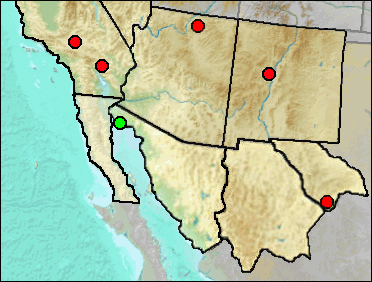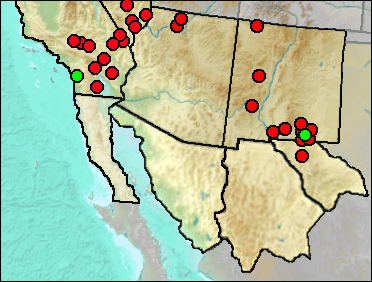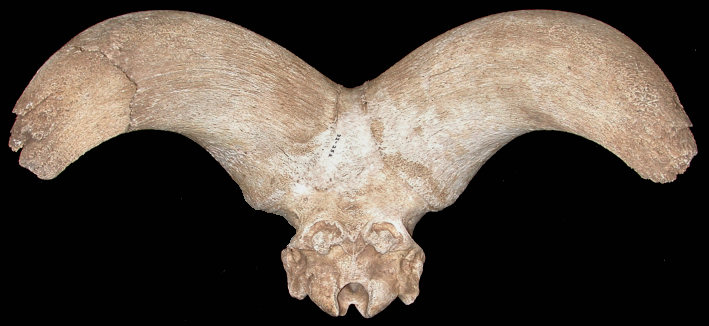Class Mammalia
Order Artiodactyla
Suborder Ruminantia
Family Bovidae

Cockerell (1930) reported a small fossil fauna from Terlingua that included Ovis, as well as vampire and leaf-nosed bats, noting that most of the material was too fragmented for specific identification. The material from the Isleta Caves quite likely represents domestic sheep.
Croxen et al. (2007) listed "Ovis sp. nov. (mountain sheep)" without further comment.
Sites.
Irvingtonian: El Golfo (Croxen et al. 2007).
Rancholabrean: Pinto Basin (Jefferson 1991c); Terlingua (Cockerell 1930).
Mid Wisconsin: Shonto (McDonald et al. 2004)
Late Wisconsin/Holocene: Isleta Caves (Harris 1993c); Schuiling Cave (Jefferson 1991b).
Literature.
Cockerell 1930; Croxen et al. 2007; Harris 1993c; Jefferson 1991b, 1991c; McDonald et al. 2004; Wilson 1942.

Synonyms. Ovis auduboni Merriam 1901, Ovis catclawensis Hibbard and Wright 1956. Ovis auduboni later was characterized as a large, massive subspecies of O. canadensis, thus accounting for assignment of late Pleistocene sheep from our area to this taxon. Ovis catclawensis was described from Catclaw Cave in Mohave County, Arizona, as differing "from the known North American Recent and fossil species of Ovis by its larger size and wider lower premolars and molars (Hibbard and Wright 1956:106).
 Harris and Mundel (1974) recorded the presence of a very large Bighorn Sheep
from Charlies Parlor, Animal Fair, Dry Cave.
Harris and Mundel (1974) recorded the presence of a very large Bighorn Sheep
from Charlies Parlor, Animal Fair, Dry Cave.
Fig. 1. Bighorn Sheep posterior skull and horn cores from Charlies Parlor, Dry Cave. UTEP 22-252.
The measurements of the specimens (posterior skull with horn cores, fragmentary dentary with p4-m3, and a partial M3) compare favorably with or are larger than those of the holotype of Ovis catclawensis. Bone material 14C dated at 15,030 ± 210 BP came from the same level. Noting that this indicates that large Ovis, also reported elsewhere at earlier dates in the Pleistocene (Stokes and Condie 1961), survived to near the end of the Pleistocene, Harris and Mundel concluded that the simplest explanation for the pattern of late Wisconsin and post-Pleistocene size characteristics in Ovis was that the large-sized sheep (Ovis catclawensis) represented Ovis canadensis that decreased in size at the end of the Pleistocene. The evidence would suggest that this decrease in size occurred in perhaps less than 2000 years. Harris and Mundel synonymized O. catclawensis with O. canadensis while noting that the large-sized taxon could be recognized as a chronologic subspecies, O. canadensis catclawensis.
Smartt et al. (1990) likewise noted that measurements of the Witch Cave specimen are larger than those of modern O. canadensis, but in line with late Pleistocene fossils. They assigned the remains to O. c. catclawensis.
Sites.
Medial Irvingtonian: Slaughter Canyon Cave (Morgan and Harris 2015).
Late Irvingtonian: Elsinore: Pauba Formation (Pajak et al. 1996: cf.).
Irvingtonian/Rancholabrean: Manix Lake (Jefferson 1991b).
Rancholabrean: Bloomfield (Morgan and Lucas 2005; Stovall 1946); Boulder City (Jefferson et al. 2015, Stokes and Condie 1961); Bow Willow (Jefferson 2014); Campbell Hill (Jefferson 1991b: cf.); Desert Sunlight Project (Jefferson 2014); Palomas Creek Cave (Harris 1993c).
Rancholabrean/?Early Holocene: Mitchell Caverns (Jefferson 1991b: cf.).
Wisconsin:Witch Cave (Smartt et al. 1990).
Mid Wisconsin-Holocene: Lower Sloth Cave (Logan 1983: O. canadensis and O. c. catclawensis); Shelter Cave (Harris 1993c).
Mid/Late Wisconsin/Holocene: Glendale (Jefferson et al. 2015); Sierra Diablo Cave (UTEP).
Mid/Late Wisconsin: CC:5:5 (Mead et al. 2003); Pintwater Cave (Hockett 2000); Rampart Cave (Carpenter 2003).
Late Wisconsin: Antelope Cave (Reynolds, Reynolds, Bell, and Pitzer 1991); Dust Cave (Harris and Hearst 2012); Gypsum Cave (Glowiak and Rowland 2003); Muskox Cave (Logan 1981); Charlies Parlor (Harris and Mundel 1974);
Late Wisconsin/Holocene: Burnet Cave (Schultz and Howard 1935); Miles Avenue Bridge (Jefferson 2014); Calico Lakes (Jefferson 1991b); Catclaw Cave (Hibbard and Wright 1956); Kokoweef Cave (Reynolds, Reynolds, et al. 1991); Newberry Cave (Jefferson 1991b); Pendejo Cave (Harris 2003); Stanton's Cave (Harington 1984); Williams Cave (Ayer 1936).
Literature.
Ayer 1936; Carpenter 2003; Glowiak and Rowland 2003; Harington 1984; Harris 1993c, 2003; Harris and Hearst 2012; Harris and Mundel 1974; Hibbard and Wright 1956; Hockett 2000; Jefferson 1991b, 2014; Jefferson et al. 2015; Logan 1981, 1983; Mead et al. 2003; Morgan and Harris 2015; Morgan and Lucas 2005; Pajak et al. 1996; Reynolds, Reynolds, et al. 1991; Reynolds, Reynolds, Bell, and Pitzer 1991; Schultz and Howard 1935; Smartt et al. 1990; Stokes and Condie 1961; Stovall 1946.
Last Update: 16 Feb 2016